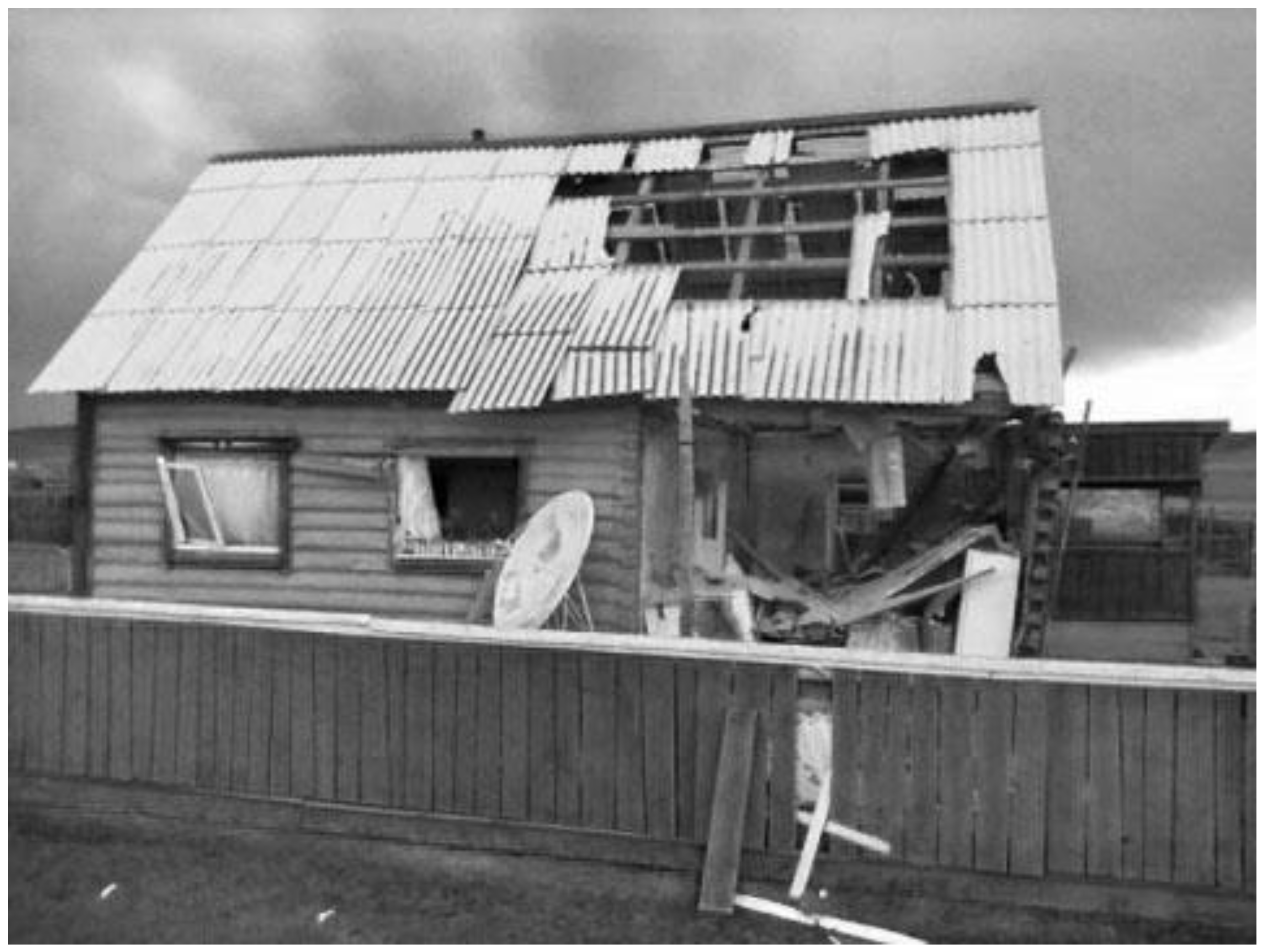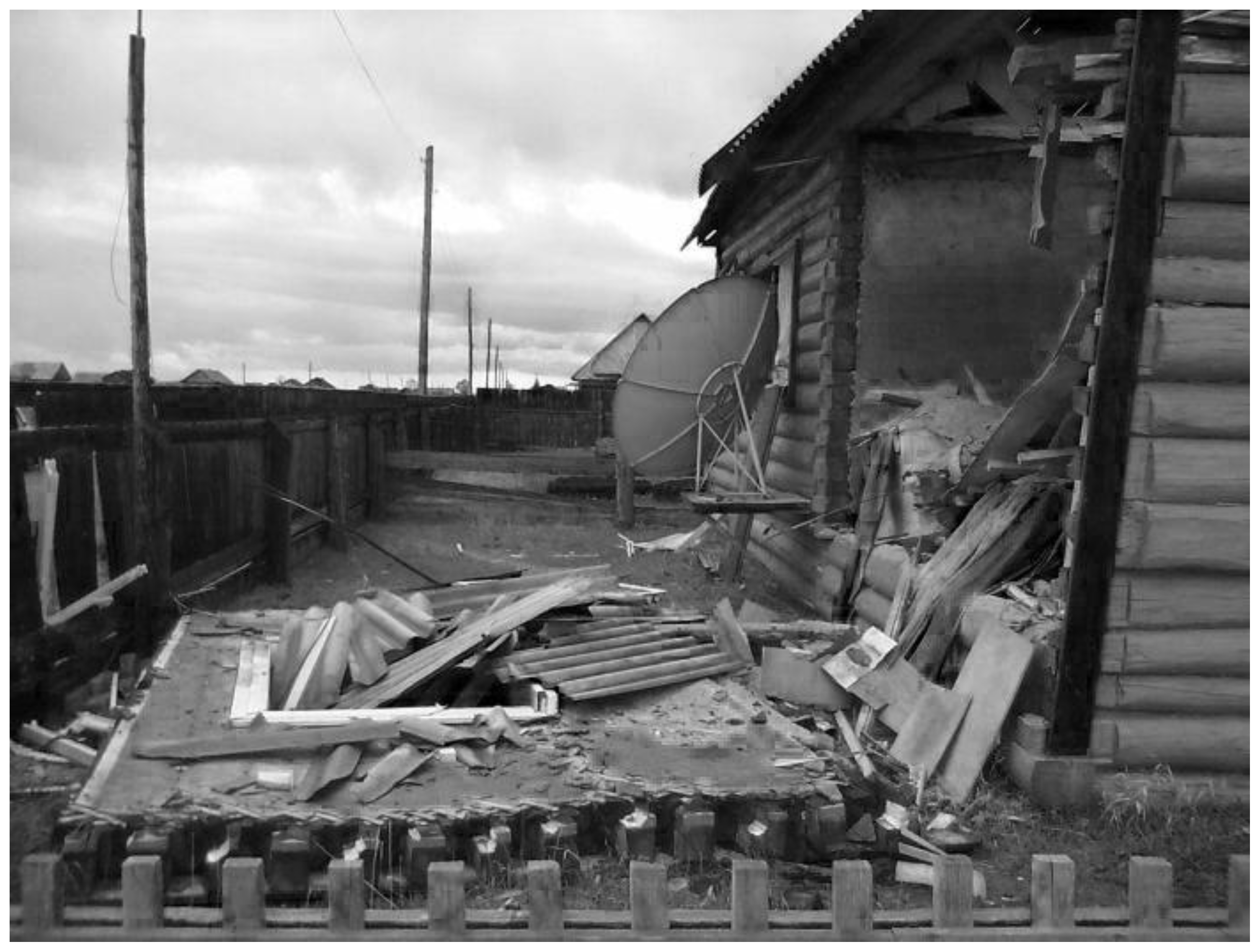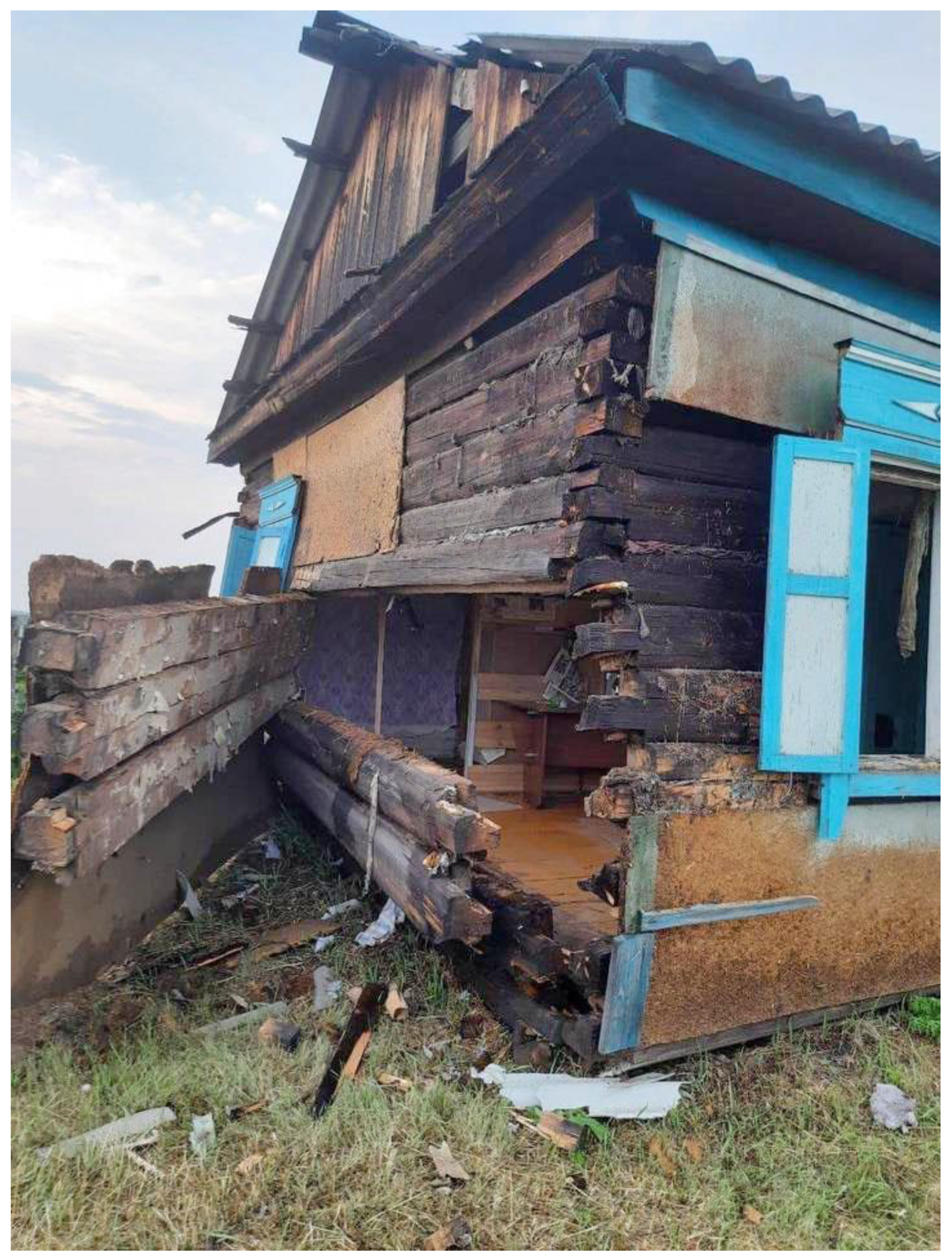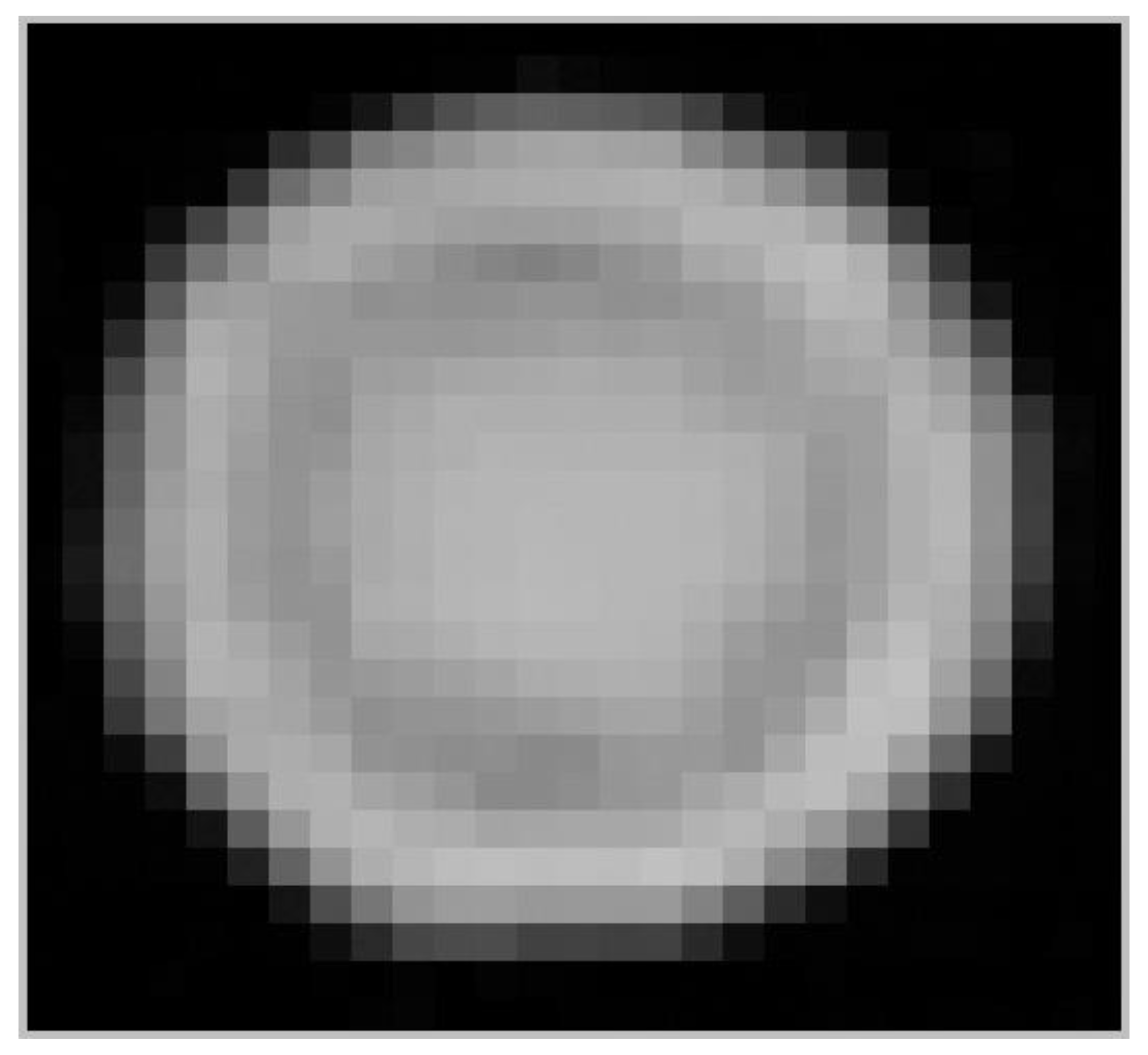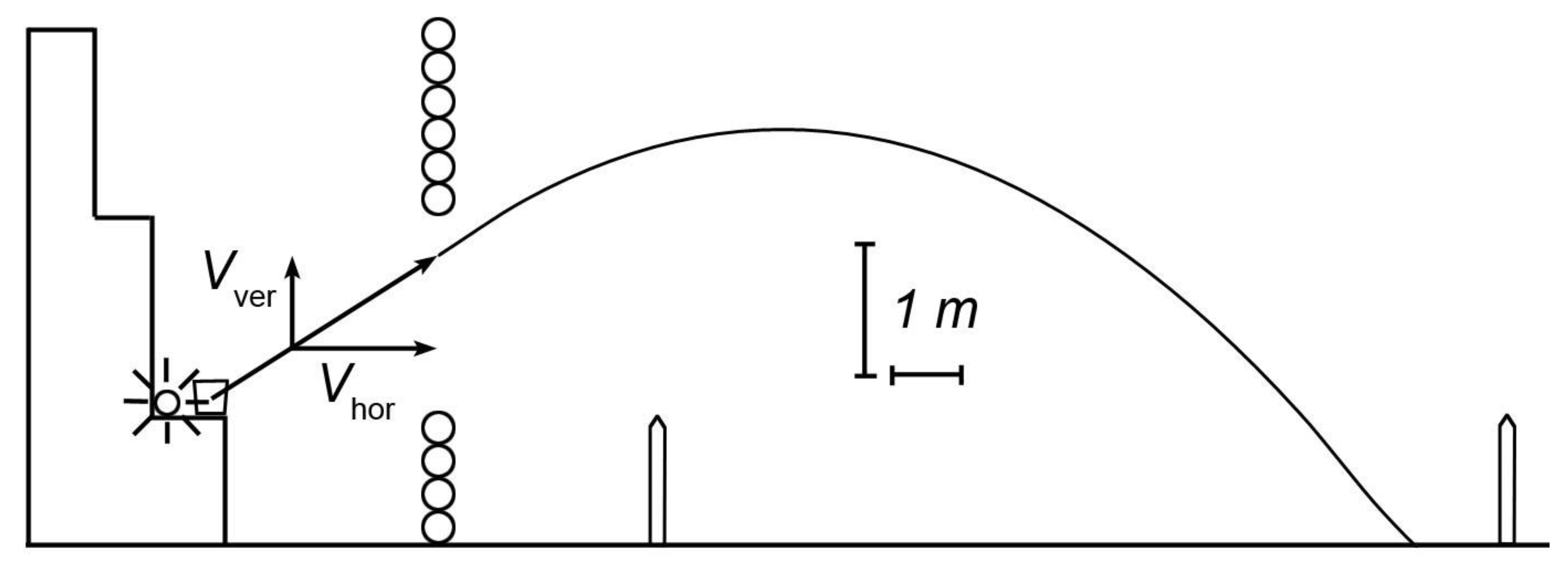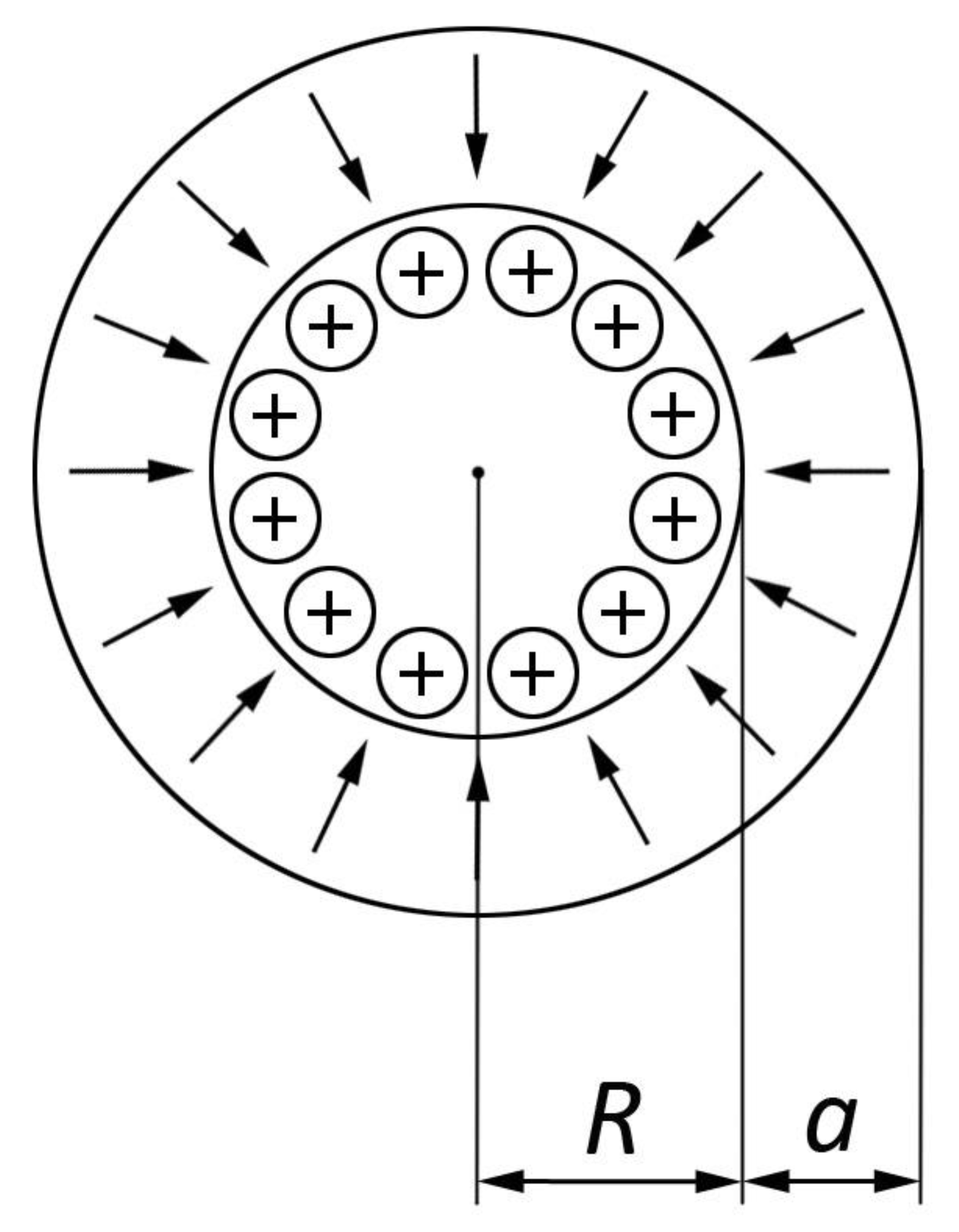1. Introduction
Ball lightning is an autonomous luminous formation moving in air, which usually appears during a thunderstorm [
1,
2,
3,
4,
5,
6,
7,
8,
9,
10,
11,
12,
13,
14,
15,
16,
17,
18,
19,
20,
21,
22,
23,
24,
25,
26,
27,
28,
29,
30]. Ball lightnings have the shape of a sphere ranging in size from a centimeter to ten meters. They can exist from a few seconds to tens of minutes. They emit light—sometimes dim, sometimes bright. Their color may vary. They “float” in the air like balloons. The direction of their movement can be any, but often, once near the ground, they move at a certain height parallel to its surface. Sometimes they fly, carried away by the wind, but sometimes they are not carried away by the wind and even move towards the wind. If they collide with a person, they can shock him or her with an electric shock. Cases of animals being injured by electric currents created by ball lightning when striking the ground have also been described. Once in a container of water, ball lightning can heat the water to a boil. Based on the analysis of such cases, it was found that the energy density stored inside ball lightning can be about 10
10 J/m
3 [
31]. Finding ball lightning close to the human body can lead to the heating of the blood and damage to the muscles [
32]. Ball lightning can end its existence by quiet extinction, collapse or explosion. Before exploding, it emits a bright flash of light. In this case, ring-shaped metal objects can evaporate [
14,
33]. Once, having exploded near the ground, ball lightning left about 0.5 m
3 of sintered soil granules [
34]. Cases have been described when ball lightning moved for some time next to a flying aircraft, dug ditches in wet soil, or left behind deep holes. [
35,
36]. There are known cases when ball lightning lifted heavy objects into the air and carried them over dozens of meters [
37]. The listed properties of ball lightning have been confirmed by numerous observations. The task of any model of ball lightning is to explain the entire set of these observations.
Let us trace the history of the emergence of hypotheses about the structure of ball lightning. The first stage of this process was to deny the existence of this phenomenon. This was justified, since the only “device” that recorded this phenomenon was the human eye. A person is an unreliable “tool”, since self-hypnosis is possible, the appearance of an afterimage on the retina after a bright flash, etc. Doubts were overcome when the first photographs of ball lightning were taken. The biggest surprise was the ability of ball lightning to “float” in the air. Therefore, it was natural to assume that it was constructed according to the principle of a balloon: a shell filled with hot gas, the levitation of which is ensured by the equality of the gravitational force and the Archimedean force [
16]. Numerous shortcomings were immediately identified in this model: the inability of ball lightning to move in a vertical direction and against the wind, and to exhibit electrical effects. The main disadvantage of this model is the inability to explain the presence of a large energy reserve in ball lightning. It turned out that to explain the energy of ball lightning, it was necessary to assume that each gas molecule must have the energy of several keV (while the ionization energy of the molecules that make up the air does not exceed 10 eV). To explain this discrepancy, it was suggested that the energy source of ball lightning is nuclear reactions [
38]. But in this case, ball lightning should be radiation hazardous. The literature describes only one case of the appearance of symptoms of radiation sickness in a group of people who were close to an exploding ball lightning [
39]. In the overwhelming majority of cases (including those described in this article), people who suffered from a nearby explosion of ball lightning did not have radiation sickness. Despite this, the balloon model of ball lightning is still discussed in the literature [
40], and antimatter [
41] or miniature black holes [
42] were proposed as keepers of its energy. In the mid-20th century, a number of hypotheses emerged in which ball lightning was considered an electrical discharge burning in air [
43,
44,
45,
46,
47,
48]. These models could describe the nature of ball lightning’s glow and some features of its movement. However, they had difficulty explaining the large energy reserve of ball lightning. To explain the effects of the release of high energy, some authors had to resort to the hypothesis of the existence of a certain channel in nature that constantly supplies ball lightning with energy. Attempts were made to find such a channel, but they were unsuccessful. Moreover, according to observations, ball lightning behaves like a material body. It can rotate, bounce off obstacles, and split into parts [
1,
2,
3,
7,
8,
9,
11,
13,
14,
15,
17,
18,
19,
20,
21,
22,
24,
26,
28,
29,
30,
49].
In 1859, de Tessan proposed a model of ball lightning in the form of a capacitor consisting of two spheres with a common center, charged with electricity of different signs [
50]. The total charge of the system was considered equal to zero. The mutual attraction of the spheres should have been prevented by the pressure of the gas located between them. An assessment of the magnitude of the electric field energy accumulated in such a capacitor showed that it cannot be more than several joules [
14]. The development of the de Tessa model was a proposal to compensate the force of the attraction of oppositely charged spheres by rotating the outer sphere [
51,
52,
53]. However, in this case, the compensation of the attractive force of the shells by the centrifugal force occurs only in the equatorial part of the system. It is not clear what forces prevent the shells from approaching each other at the poles. In addition, it is clear that this system will tend to expand, since it lacks the force to hold the inner sphere in place. If there is a vacuum inside this system, then the expansion can be stopped by the force of atmospheric pressure acting on the outer sphere. According to the virial theorem, the energy density ρ
E inside the sphere is related to the external pressure
P on the wall of the sphere by the relation ρ
E = 3
P [
5]. Substituting
P = 10
5 N/m
2 (atmospheric pressure), we obtain ρ
E = 3·10
5 J/m
3, which is significantly less than the value ρ
E = 10
10 J/m
3 determined based on the Goodlet [
31] calculations of ball lightning energy. Dijkhuis [
54] suggested that electrons can become bound if brought close together. In this case, vortex tubes with a radius of 5.3·10
−11 m formed from electrons. Positive ions rotate around the tubes in an orbit with a radius of 10
−7 m. According to his model, ball lightning is an object of vortex tubes densely packed within the volume of the ball. The total charge of the system is zero. Geoffrey Endean [
55] proposed a model of ball lightning in the form of a bubble with a plasma shell, inside which electromagnetic radiation circulates. Later, ball lightning with the same device was considered in article [
56]. The reason for the long glow of ball lightning is explained by some researchers by the fact that this occurs due to chemical reactions on its surface. According to the Smirnov’s airgel model [
16], ball lightning is a frame made of airgel threads. There are individual dots on it that glow due to heating in the oxidation reaction of organic matter. In the Abrahamson–Dinnis model [
57], ball lightning glows due to the oxidation of silicon ejected from the soil by a linear lightning strike. The unusual property of ball lightning—the ability to freely pass through glass—has led to the proposal of theoretical models of electromagnetic field configurations with zero outward energy flow [
58,
59]. Such models are of purely theoretical interest and have no relation to real ball lightning, since, for example, in the Cameron [
59] model it is assumed that the configuration of electromagnetic fields is of infinitely large size.
When starting work on our model of ball lightning, we took de Tessan’s idea as a basis and assumed that the element of its energetic core is a system that we called a “dynamic electric capacitor.” [
60,
61,
62,
63,
64,
65]. According to our assumption, this capacitor consists of electrons moving in a closed orbit and positive ions rotating around the location of the electrons. Such a system of moving charges is similar to the device of a hydrodynamic capacitor, studied in the work of [
66]. The movement of electrons is controlled by the combined action of an electric field and a magnetic field generated by the movement of ions. Calculations have shown that to create a sufficiently strong magnetic field, the number of ions in this system must exceed the number of electrons, that is, the “dynamic capacitor” must be positively charged. Because of this and because of the “looseness” of the electron core, it tends to expand. The only way to prevent this expansion is to place it in a container that can withstand the pressure of a ball lightning core consisting of an ensemble of expanding capacitors. We set out to find the source of a centrally symmetrical spherical force, compressing the region within which there is a substance possessing kinetic energy with a density of 10
10 J/m
3. According to the virial theorem, the pressure on the core of ball lightning should be no less than 3.3·10
9 Pa, and a spherical container with radius
R = 0.1 m should be compressed with a force
F = 4·10
8 N. We assumed that the force compressing the core may appear due to the fact that the nucleus has an uncompensated electric charge
Q. If a charge is placed inside a dielectric shell of thickness
a, then due to the polarization of the shell molecules in the inhomogeneous field of the charge, a force will appear, the magnitude of which is proportional to the gradient of the electric field, that is, the magnitude of the charge
Q. In contrast to this, the force of the Coulomb repulsion of charges acting on the shell is proportional to the square of the charge
Q2. In the region from
Q = 0 to
Q =
Qmax,
Q >
Q2. Estimates have shown that for the typical sizes of ball lightning from 10 to 100 cm, the equality of the forces compressing and stretching the shell occurs in the range of the charge values of
Q = 10
−3–10
−1 C and the thickness of the shell consisting of water molecules,
a = 1–10 cm. This method of solving the problem at first glance seems paradoxical: in addition to the requirement of compensating for the force caused by the movement of the molecules, we also added the need to create a force that prevents the Coulomb repulsion of the charges. It turned out that part of the thickness of the shell is “responsible” for compensating the force created by movement of the molecules, and part of it is for compensating the force of the repulsion of the charges. In fact, it turned out that we returned to the idea of de Tessan’s electric capacitor, but in a new form. Our ball lightning is one of the electrodes of a large capacitor, the second electrode of which is the ground. The breakdown of this capacitor is prevented by the dielectric shell and a layer of air. The configuration we proposed was supported and successfully developed by the authors of some models of ball lightning [
30,
67,
68,
69,
70]. The idea that ball lightning is a unipolarly charged object has made it possible to find answers for many “strange” features of ball lightning behavior. It turned out that the complex nature of ball lightning movement is explained by the interaction of its charge with the electric fields of the atmosphere. When in close contact with conductors, ball lightning changes the properties of a nearby medium due to the process of draining its charge [
71].
The presence of a charge in ball lightning is a fact confirmed by observations and does not require additional proof. The purpose of this article is to show how this property of ball lightning allows us to find an explanation for many actions of ball lightning, which remained a mystery for many years and even gave reason to attribute them to phenomena that contradict the “laws of science” [
14]. In this article, we consider only the destruction caused by the action of the ball lightning charge (that is, the energy of the electric field of the capacitor), and we do not take into account the additional effect of the kinetic energy of the nucleus. The basic idea of our article is the assumption that ball lightning is an ensemble of charge carriers of the same sign, collected inside a dielectric shell. If the shell is intact, they are located in a small area of space. When the shell ruptures, for example, due to mechanical damage, they scatter in all directions.
Figure 1 shows an example of such an event that occurred when ball lightning collided with a car. It can be seen that fragments of the ball lightning core, flying out of the shell, take the form of a rapidly expanding luminous ball. It is natural to assume that this can be explained by the fact that the fragments have an electric charge of the same sign. If a ball lightning explosion occurred inside a region of space bounded by walls, then the scattered charges would remain on the walls for some time, trying to push them apart. The results of this action of charges can be found in the following descriptions of events that occurred during the explosion of ball lightning inside closed rooms.
2. Cases of Ball Lightning Explosions inside Enclosed Spaces
The literature describes many cases of indoor ball lightning explosions. As a rule, the result of an explosion is a bang, accompanied by a wave of air, melting electrical wires and the appearance of burn marks on painted floors [
19,
21,
24,
26]. However, in the history of ball lightning observations, there were several cases when its explosion indoors led to great destruction. These cases are very rare. In his book, Brand [
3] spoke of a ball lightning explosion in the village Poggio-Tre-Crossi in 1914, which led to the destruction of the local church. Six similar cases are described in books [
14,
30,
72]. The rarity of these cases is somewhat supported by the fact that, according to a review by Keul [
73], such an event has never been witnessed by qualified scientists in their lifetime. This state of affairs is apparently explained by the fact that in nature there are two types of ball lightning: with a large and a small supply of energy. This is confirmed, for example, by the conclusion of Stakhanov [
21] about the existence of two types of ball lightning—short-lived and long-lived. The same opinion is shared by Rakov and Uman [
74], who believe that there may be several types of ball lightning and several ways of generating it in nature. In our article [
75], we suggested that two types of ball lightning that differ in the activity of its energy core can exist. Ball lightning with a low energy reserve has a core of slow-moving charge carriers (possibly ions), and the core of ball lightning with high energy consists of dynamic electrical capacitors—objects that can contain high energy. In our opinion, these two types of ball lightning should differ in color. The reason for the glow of low-energy ball lightning is a corona discharge on its surface, which supports the emission of excited NO
2 molecules in the violet part of the spectrum. In high-energy ball lightning, the glow generated by the movement of the elements of its core is added to the glow of the shell, so the total spectrum shifts to the red region. The assumption that different types of ball lightning exist in nature is supported by the dependence of the lifetime of ball lightning on its size, discovered by Bychkov et al. [
76,
77]. It turned out that large ball lightning lives longer than small ball lightning. This can be explained by the fact that the energy spent on the formation of the former is much greater than the latter.
After this short introduction, we will discuss the results of events that occurred during high-energy ball lightning explosions inside confined spaces.
On the afternoon of 27 May 2013, in the Buryat village Mogsokhon, in Russia “nothing foreshadowed a tragedy. At 15 o’clock, the usual rain began, but suddenly thunder of such force struck that people ducked to the ground in fright and ran in different directions. The minute after, a luminous ball descended from the sky and entered the house of Bayan Sandanov’s family through the roof. A deafening explosion thundered in the house. At the time of the explosion, the house was attended by the hostess, Rada Sandanova, who was cleaning the kitchen after lunch. She found herself under the rubble of a wall and received a serious concussion, partially losing her hearing. The victim was admitted to the hospital, now her health has recovered” [
78]. The explosion of ball lightning caused the wall of a log house to fall out, windows and doors were squeezed out, and slate sheets were torn off and scattered on the roof of the house (
Figure 2 and
Figure 3). The energy of the explosion of this ball lightning, estimated by the similar action of a TNT charge, turned out to be equal to 30–130 MJ [
79].
The same type of destruction is shown in
Figure 4. The result of a ball lightning explosion inside the house of Igor Taryashinov can be seen in it. The explosion took place on 28 July 2021 in the village of Kyren in the Tunken region in Buryatia. The explosion knocked out part of a log wall, knocked out windows and damaged furniture in the house. It should be noted that the fact that the destruction of the house, caused by an explosion of ball lightning, does not look like a break and collapse, as occurs with the explosions of condensed substances. It is more like a slow “dismantling” of the structure of the house.
The sad history of accidental explosions of solids (for example, saltpeter) or air-gas mixtures tells us that these explosions are always accompanied by numerous human casualties [
80]. In our case the most surprising thing was that the mistress of the house, who was next to the ball lightning at the time of the explosion, was injured, but remained alive. In
Figure 5 Rada Sandanova is shown in July 2013 (two months after the event).
On 9 December 1956, in the city of Maykop, Russia, during a severe thunderstorm, three ball lightnings were formed. One of them entered a house through a radio transmission line, burned electrical wiring, smashed the power meter and exploded into two fireballs. The explosion lifted the ceiling and pushed the walls of the house apart. Then, one of the balls broke through the wall of the house and flew out into a courtyard [
14]. On 24 July 1967, “a bright white ball lightning about 20 cm in diameter flew into a country house. There was a sharp and powerful explosion, and a bright flash was visible at a distance of hundreds of meters.
The audibility in transistor receivers fell sharply. A brick wall, a brick oven and a wardrobe were destroyed in the house. The log walls were “kicked out”, and the window frames were also knocked out” [
72]. “On 12 March 2008, in the village of Sinitichi, in the Kamenets district of the Brest region of Belarus, at about 19:40, a blinding flash of light was observed, accompanied by a roar. In the village, in an instant, all the TVs turned on and burned out, the lights went out, the phones went silent, and windows flew out in one of the houses. The house, where 42-year-old Vyacheslav Kislyak lived, was in the midst of a terrible destructive force. Something of enormous power exploded in one of the rooms of his house. One of the walls of the solid wooden house was completely blown out by the shock wave, the window frames flew out a dozen meters, and the roof with the miraculously survived slate folded in half. The owner of the house, at the moment when half of the house was blown to pieces, was lying on a bed near the wall opposite the one that had been blown out by the blast wave. The lucky one got off with a few scratches on his face. According to Oleg Boyko, the head of the fire emergency and rescue post, a ball lightning that flew into the house could have been the culprit of such a powerful explosion. All the wiring in the house burned out, as if the voltage in the wires had jumped to a monstrous size. Oleg Boyko believes that ball lightning flew into the house through the chimney. There was no thunderstorm that evening, but it was drizzling lightly” [
81].
In the summer of 1938, in the Vologda Oblast, Russia, “an orange ball the size of a soccer ball flew into the smithy. At a quarter of its radius, it was covered with a translucent shell of a dark-blue-blue color, which shimmered, streamed and rotated with the ball above the forge for a minute. Then, the ball from the forge moved to the opposite wall. There was a crack of wood, and the whole wall fell flat to the ground. The strong smell of sulfur had appeared in the room” [
26]. Note that during this action of ball lightning, the witness was inside the smithy, and he remained alive.
We find a vivid description of the action of ball lightning in the book by Imianitov and Tikhiy [
14]. “This incident took place in August 1924 in the village of Gvozdki, in the Valdai District of the Novgorod Region of Russia. At about two o’clock in the afternoon, a heavy pouring rain began with gusts of squally wind. There were two people in the Savushkins’ house: the eldest daughter Anna, 23–25 years old, and the youngest son Alyoshka, 8–10 years old. Alyoshka sat down on the bench and began to look out the window. On the top of the Russian stove was a dough tub covered with a clean homespun tablecloth. Suddenly, in the entryway, Anna fell to the floor from a strong crash and shaking of the entire building. As she fell, she heard the crackle of a wood splitting in the garret. Having regained consciousness, she first threw herself into the hut. Running into the hut, she saw that the windows were without frames, and Alyoshka was not at home. Frightened, she ran to the window, and couldn’t believe her eyes: Alyoshka was sitting in the garden by the fence beyond the road. There were three frames lying next to them and there was the dough tub, as if it had been placed there. Shouting in fright: “Alyoshka, how did you end up there?!”, she ran out of the hut. Anna well remembered that, going out into the entrance, she left Alyoshka sitting on the bench, and the windows were closed. The neighbor, Uncle Misha said that he saw something incredible. Two lightning bolts simultaneously flashed over the ridge of the Savushkins’ roof, and a bright blue ball the size of a fist separated from them. The ball jumped into the chimney pipe after the flash. Having passed the straight chimney, it hit the stone slab of the top of the stove, on which there was the dough tub, and exploded. From the explosion, all the frames, the dough tub and the boy Alyoshka flew into the street. The blast wave carried them across the road through the first fence to the second fence of the garden. The frames were lying on the ground with partially broken glass. Alyoshka fell, but did not hurt himself, then sat down by the fence. This is how Anna saw him from the window. The upright dough tub stood next to the frame, but there was no tablecloth on it”.
3. Analysis of the Action of Ball Lightning Explosion Indoors
According to observations, ball lightning consists of a luminous spherical core, surrounded by a shell (
Figure 6) [
75]. The ball lightning model is easier to understand by considering the structure of multiply charged clusters—miniature ball lightning (
Figure 7) [
82,
83]. The cluster is considered as a sphere filled with ions of the same sign, which is compressed by a shell of polarized water molecules. Clusters are formed during electrical discharges in water [
84,
85]. The size of such clusters is about 10 μm. We believe that ball lightning is “built” according to the same scheme as a multiply charged cluster. The only differences between these systems: the size of the average ball lightning is 10
4 times larger than the size of the cluster, and inside the shell of the ball lightning there are not just ions, but unipolar charged elements formed from electrons and ions rotating in closed orbits. Most likely, it is these elements (which we call dynamic electric capacitors) that witnesses of ball lightning see when they talk about sparks moving inside the shell [
21,
26]. The dynamic electrical capacitors are carriers of kinetic energy and of electrical charge. Therefore, they “press” on the shell with a force that is greater than the force that stretches the shell due to the Coulomb repulsion of the stationary ions’ charges. To keep things simple, let us assume that, as in a cluster, the expansion of the shell of ball lightning occurs only due to Coulomb repulsion of charges. Using the scheme for calculating the structure of clusters, let us consider a sphere with a radius
R = 10 cm, inside which there are ions with a total charge
Q = 10
−2 C. This charge will create, on the surface of the sphere, a field with intensity
Here ε
0 = 8.854·10
−12 F/m is a dielectric constant. Due to the Coulomb repulsion, the ions will stretch the sphere with a force
Let us place one water molecule, which we will consider as a ball with a diameter
dw = 4·10
−10 m, on the surface of the sphere. The dipole moment of the water molecule is
pw = 6.327·10
−30 C/m. The striving of a water molecule to orient its dipole moment in the direction of the electric field vector is hindered by the thermal movement of the molecules. In order for the direction of this dipole to be oriented along the electric field vector
EQ, the Langevin condition
EQ >
Emin = 3
kBT/
pw = 2·10
9 V/m must be satisfied [
86]. As one can see, this condition is met, which means that all water molecules on the sphere’s surface will be completely polarized. The water molecule is attracted to the center of the sphere by the force
On the surface of the sphere
S = 4π
R2 with radius
R = 0.1 m,
nw =
S/
dw2 = 7.85·10
17, water molecules can fit, and the compression force of the sphere by the monolayer of water molecules becomes equal to
F1w =
Faw·
nw = 0.893 N. Water molecules located on the surface of the sphere will tend to push out their “neighbors”, this will result in a weakening of the force attracting them to the center of the electric charge. In the work [
82], this force was calculated for micron-sized clusters. It was shown that the force of water molecules pushing out of a shell of radius
R is described by the formula
where
R is measured in angstroms (10
−10 m), and
R0 = −4.5. According to this formula, the force
Fr turns out to be noticeable at values of
R~10
−9–10
−8 m; at the values of
R~10
−1 m it can be neglected. The force
F1w = 0.893 N is 5·10
7 times less than the force
FQ with which the ions stretch the surface of the sphere. The values of the forces that stretch and compress the sphere can be equalized if the number of the layers of the water molecules is increased by 5·10
7 times, that is, the shell thickness is increased to
a =
dw × 5·10
7 = 2 cm. As a result, we get an object with an inner sphere radius
R = 10 cm and shell thickness
a = 2 cm, which can hold a charge of
Q = 10
−2 C inside itself. Charge carriers (ions in multiply charged clusters or dynamic capacitors in large ball lightning) will try to penetrate outward through the shell due to the action of the electric field of the core. Sooner or later, they will be able to do this, so the lifetime of any ball lightning is limited. But if in a cluster with its thin shell and small ion size this can happen quite quickly (in a few seconds), then the large size of the dynamic capacitor (1 mm) and the large thickness of the ball lightning shell (1–10 cm) give it a chance to extend the drainage time of the charge up to dozens of minutes.
In the water molecule, the distance
dh between the oxygen atom and the plane in which the hydrogen atoms are arranged is 0.588·10
−10 m. Thus, the molecule can be considered as a dipole of length
dh, at the ends of which there are charges
qd =
pw/
dh = 10
−19 C. The distance between water molecules in ice crystal is about 3·10
−10 m. Therefore,
ns = 10
19 water molecules can be placed on an area 1 m
2. The total charge of the ends of the dipoles over an area 1 m
2 is σ =
qd·
ns = 1 C/m
2. In calculations, it is convenient to use the idea of a water shell consisting of dipoles, the length of which is equal to the thickness of the shell
a, and the charge density on surface of the sphere is σ = 1 C/m
2. With this representation, the force
Fsh compressing the shell is equal to
Equating
Fsh and
FQ (Formula (2)), we find
Let us try to find an explanation for the described events. In the case of the ball lightning explosion in the smithy, its size (diameter 2
Rbl = 20 cm) and shell thickness (
a = ¼
Rbl = 2.5 cm) are indicated. Knowing these dimensions, we can find that the charge of this ball lightning was
Qbl = 9.42·10
−2 C. Suppose that when the ball lightning had exploded in the smithy, its charge was evenly distributed over the surface of the walls, ceiling and floor of the room. Let us consider this room as a cube with an edge side
Lr = 4 m. For a sphere with a radius
Rsp = 2 m, the force with which the charge
Qbl pushes the surface,
The pressure on the surface of the sphere is
Let
Psp be the pressure be exerted on the smithy’s wall with a surface area
Sr = 4 m × 4 m = 16 m
2. Hence the force pressing on the smithy’s wall is
Fr =
Psp × Lr2 = 3.17∙10
6 N = 324 t. When this force appears, the log wall of the room will begin to move. Let us determine the time during which the wall acquires the velocity of
v = 1 m/s. Let the thickness of the wall be equal to
b = 20 cm. The volume of the wall is
Vw =
Lw2·
b = 3.2 m
3. Let us take the specific weight of wood to be equal to ρ
w = 0.8·10
3 kg/m
3, from here we find the mass of the wall
Mw =
Vw·ρ
w = 2.56·10
3 kg. Under the action of force
Fr, the wall will begin to move with acceleration
a =
Fr/
Mw and acquire a velocity
v = 1 m/s after a time
t =
v/
a =
v·
Mw/
Fr = 8·10
−4 s. Thus, in order for the wall to accelerate to a velocity of
v = 1 m/s, it must hold a charge
Qbl/6 = 1.6·10
−2 C for a time greater than 10
−3 s. The charge of the exploding ball lightning hits the inner surface of the room wall. In order to drain to the ground, it must move to the outer surface of the wall. The time of this transition is determined by the electrical resistance of the logs of the house. The walls of a room with an area of 4 × 4 m
2 with a ceiling height 4 m represent a capacitor, the capacity of which is close to the capacity of a spherical capacitor with a radius
r = 2 m:
C = 4πε
0r = 2.22·10
−10 F. In order for the time τ of the charge to remain on the wall for about one second, the resistance to charge movement through the wall should be no less than
R = τ/
C = 4.5·10
9 Ohm. The values of the volumetric electrical resistance of natural dielectric materials (shellac, rosin) lie in the range ρ = 10
13–10
14 Ohm·m [
87]. It is quite possible to obtain the required value ρ = 2.25·10
10 Ohm·m for a dry log 0.2 m thick. The further fate of the charges passing onto the outer surface of the wall does not matter. They can slowly drain due to the conductivity of the air or go into the ground through some kind of conductor.
Let us try to understand the event that took place in the village Gvozdki [
14]. Let us assume that the top of the stove was 1 m higher than the floor level and it was at a distance 3 m from the window (
Figure 8). Let the height of the windowsill be 1 m, and the vertical size of the window 1.5 m. Let us assume that the ball lightning exploded in the corner between the top of the stove and the wall of the oven, 0.5 m away from the dough tub. Being flown out the window, the dough tub flew horizontally 3 m to the first fence of the garden and an additional 11 m of the width road and its shoulders, 14 m in all. In order for the dough tub to fly out of the window, it had to fly at an angle α, the tangent of which is not more than tan α = 1.2 m/3 m = 0.4 (α = 21.8
0). At the moment of departure from the window, the dough tub was at a height of
h0 = 2.2 m, and the ratio of the vertical and horizontal components of its velocity was also tan α:
vver/
vhor = 0.4. It flew a distance of
l = 14 m in time
t = l/
vhor. During the time
t1, it rose to a height
h1 above level
h0, and then, during time
t2, fell from this height to the ground. Height
h1 =
g·t
12/2. The component of the kinetic energy of the dough tub of mass
m, associated with the vertical component of its velocity,
Wk =
mvver2/2, is equal to the potential energy at the highest point of the rise above the level
h0,
Wp =
mgh1. Hence,
h1 =
vver2/2
g = (0.4)
2 ·
vhor2/2
g = (0.08·
vhor2)/
g. The ascent time to height
h0 +
h1 is equal to
t1 = 0.4·
vhor/
g. The time the tub falls from this height is
The full flight time of the dough tub is
During this time, the dough tub horizontally flew from the window to the landing site over the distance of
Substituting l = 14 m, h1 = 0.08·(vhor)2/g and h0 = 2.2 m into this equation and solving it, we find vhor = 11 m/s.
Suppose that the dough tub has acquired a speed
v =
vhor/cos α = 12 m/s, repelling from the charge
Qbl, which was transferred by the ball lightning to the furnace wall. Suppose that the charge of the ball lightning was equal to 5·10
−3 C. Let us assume that the charge carriers during the explosion of the ball lightning scattered uniformly in all directions. On the unit surface of a sphere with a radius
R0 = 0.5 m (the distance between the ball lightning and the dough tub), there was a part of the charge σ
s =
Qbl/4π
R02 = 1.6·10
−3 C/m
2. The charge
qtb = σ
s·
Stb = 9.6·10
−5 C, which is about 2% of the charge of ball lightning. This charge could fall on the area
Stb = 0.06 m
2 of the dough tub section. Let us assume that the dough tub received a charge
q = 2.4·10
−5 C. The work of the force of charge repulsion is
Here R0 = 0.5 m is the initial distance between the tub and the ball lightning, and R = 3 m is the distance between the oven and the window. Substituting in (10) numerical values, we find A = 1800 J. This is equal to the kinetic energy of an object with a mass of 25 kg, flying at a speed 12 m/s. It can be assumed that approximately the same forces acted on a boy with a mass of about 15 kg. The splitting of the wooden garret and the breaking of the windows occurred due to the repulsion of the charges deposited on them during the explosion of the ball lightning.

